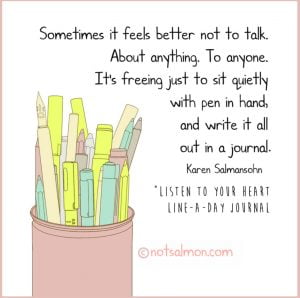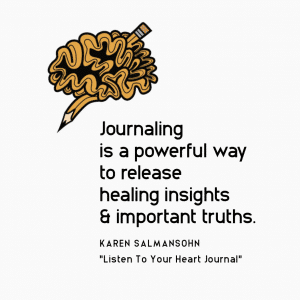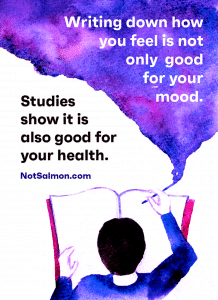 If you’re dealing with chronic stress, PTSD or depression, you might want to explore writing as a psychological therapy. Read on to learn why – and how to try this healing process.
If you’re dealing with chronic stress, PTSD or depression, you might want to explore writing as a psychological therapy. Read on to learn why – and how to try this healing process.
When we say “psychological therapy,” the first image we get in our mind is a cozy cabinet with a therapist and a daybed where we sit or lie down and tell what bothers us. However, speaking out is just one of many forms therapy can take.
Another one is expressive writing, which you can do on your own or be supervised by a professional while doing it.
In this article, I’ll explore why writing possesses therapeutic qualities, what you should know about it, and how to make this ritual work for you.
What is writing as psychological therapy?
Writing therapy is a form of expressive therapy that uses the act of writing and text processing as its main tool.
Contrary to narrative writing where the main task is to write about the events that took place, expressive writing focuses on describing the emotions and feelings connected to the experiences that we explore.
It can be individual or take place in a group and can be counseled by a professional or administered by the patients themselves. Regarding the medium, it may take a traditional pen-and-paper approach or an online one that uses digital tools. While its approach and medium vary, the benefits of writing as therapy are the same.
The benefits of expressive writing
 One of the biggest perks of writing therapy is that there are no limits to who can apply it. This is why it can be used by people who work with various industries, be that a lawyer, a nurse, or a designer.
One of the biggest perks of writing therapy is that there are no limits to who can apply it. This is why it can be used by people who work with various industries, be that a lawyer, a nurse, or a designer.
“People underestimate the power of expressing their thoughts and feelings in written form”, says Adriana Crowley, a psychology expert at PapersOwl. “In my case, writing therapy helps me disconnect from the hum and information buzz I get from everywhere, and connect with my emotions and feelings, pour out the background thoughts, clean my mind.” And the therapists say, there are a few good reasons why it happens.
The aim of writing as a therapy is to minimize stress, anxiety, reduce pain associated with some medical conditions, and speaking plainly, let it go. One of the most obvious benefits of this therapy form is catharsis, a thought of relief that comes after releasing the oppressed internalized feeling or emotions. But there are a few more.
Decreasing the degree of focus.
- Particularly when we’re talking about post-traumatic stress disorders (PTSD), chronic stress, anxiety disorders, or getting past panic attacks
Making more cognitive resources available.
- When dealing with past events and situations that caused rumination, writing ‘frees up’ space. Think of it as an analogy to computers: the less packed the processor, the more productive and faster the machine works.
Reformulating traumatic memories so they get easier accepted.
- Using writing empowers you with the opportunity to re-write your memories so they can help you pass through the negative situation and show the positive outcomes of it.
What does the process look like?
 In its traditional approach, a patient dedicates 20 minutes per day during four days to take notes about how one feels and what one thinks. The aim is to specifically write about the feelings regarding a certain event at a particular moment without assessing or dividing the thoughts and emotions into worthy or useless. Basically, you just put on paper or screen what is in your head when you think about the event.
In its traditional approach, a patient dedicates 20 minutes per day during four days to take notes about how one feels and what one thinks. The aim is to specifically write about the feelings regarding a certain event at a particular moment without assessing or dividing the thoughts and emotions into worthy or useless. Basically, you just put on paper or screen what is in your head when you think about the event.
The beauty of writing therapy is that you can do it with or without a psychologist. If you’re doing it under the supervision of a certified specialist, the process may include specific guidelines from this specialist regarding the process. The involvement of a specialist is highly desirable as your writing needs analysis. However, you can start it before visiting one or when you feel overwhelmed with emotions and need a quick shift of focus. Let’s review the tips that can bring the most efficacy to the process.
Expressive Writing Tips to Do It Right
No self-judgment.
It’s generally good to turn off the editor’s mode when you write anything, but here it’s the prerequisite of succeeding in the process. Write down your emotions and feelings like nobody’s going to read it.
Write honestly.
The point of this exercise is to look at the situation differently and reveal your true emotions to work with them. There is no need to lie to yourself as you’ll be the only one fooled.
 Have focus.
Have focus.
It might sound strange that to get rid of fixation you need to fix on something else but that’s precisely the case. The only thing you focus on while writing is your emotional state regarding the event and nothing else.
Make the ritual comfy.
If you’re going to pour out something unpleasant, the only thing to balance it is to have a setting that makes the whole process better. Memories can be tough to deal with so surround yourself with your favorite things, buy a fancy notebook or pen, make yourself a cup of your favorite beverage, and get started.
Set a goal.
Pointless writing is pointless, so write out the goal of this therapy. What do you want to achieve? How much time a day are you willing to dedicate to writing? What event are you going to write about today? What have you found bothering that event? Note down these things to help you structure the process, and your emotions will follow.
Don’t pay attention to typos or grammatical errors.
 They are the least relevant for this exercise. You aren’t doing it to score A+, you aren’t writing it to win the Nobel Prize, you’re doing it to take care of your mental health. Those petty issues can wait until the next work email or school project.
They are the least relevant for this exercise. You aren’t doing it to score A+, you aren’t writing it to win the Nobel Prize, you’re doing it to take care of your mental health. Those petty issues can wait until the next work email or school project.
Follow the 5-step pattern.
Define the situation. Reflect on it. Focus on emotions/feelings it evokes. Write them down and time yourself. Read and see which of those needs to work with a specialist.
Use prompts if you don’t have ideas.
It’s okay if you don’t know what to write, and sometimes having prompts can facilitate the mental process.
For instance, if you deal with a traumatic break-up from a toxic relationship, your prompt can be something like “Define relationships” or “What is a nice example of a relationship for you.”
In this way, you won’t focus on your situation directly but will find new angles to look at it and understand what it means to you.
NOTE: This is why I created my Listen To Your Heart Journal – to share lots of helpful writing prompts.
Writing as therapy has a lot of positive outcomes.
When you use writing as therapy you can help relieve the pain and struggle of chronic stress, anxiety, PTSD, depression, and a lot more medical conditions. Guided or self-administered, the expressive writing process can help you to release your negative emotions, let go of the situation you’ve got too fixated on, and revise your emotional state. The best part? Your better emotional state won’t cost you much.
Start writing in a journal for therapy
Think happier. Think calmer.
Think about subscribing for free weekly tools here.
No SPAM, ever! Read the Privacy Policy for more information.
One last step!
Please go to your inbox and click the confirmation link we just emailed you so you can start to get your free weekly NotSalmon Happiness Tools! Plus, you’ll immediately receive a chunklette of Karen’s bestselling Bounce Back Book!


 If you’re dealing with
If you’re dealing with  One of the biggest perks of writing therapy is that there are no limits to who can apply it. This is why it can be used by people who work with various industries, be that a lawyer, a nurse, or a designer.
One of the biggest perks of writing therapy is that there are no limits to who can apply it. This is why it can be used by people who work with various industries, be that a lawyer, a nurse, or a designer.  In its traditional approach, a patient dedicates 20 minutes per day during four days to take notes about how one feels and what one thinks. The aim is to specifically write about the feelings regarding a certain event at a particular moment without assessing or dividing the thoughts and emotions into worthy or useless. Basically, you just put on paper or screen what is in your head when you think about the event.
In its traditional approach, a patient dedicates 20 minutes per day during four days to take notes about how one feels and what one thinks. The aim is to specifically write about the feelings regarding a certain event at a particular moment without assessing or dividing the thoughts and emotions into worthy or useless. Basically, you just put on paper or screen what is in your head when you think about the event.  Have focus.
Have focus.  They are the least relevant for this exercise. You aren’t doing it to score A+, you aren’t writing it to win the Nobel Prize, you’re doing it to take care of your mental health. Those petty issues can wait until the next work email or school project.
They are the least relevant for this exercise. You aren’t doing it to score A+, you aren’t writing it to win the Nobel Prize, you’re doing it to take care of your mental health. Those petty issues can wait until the next work email or school project.